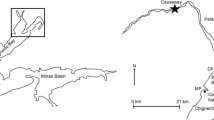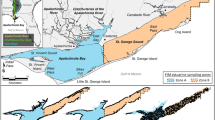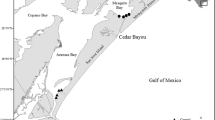Abstract
Since 1991, the Caernarvon Freshwater Diversion has been reintroducing Mississippi River water into a previously hydrologically isolated estuary in an effort to restore wetlands. To determine the effect of freshwater inflow on estuarine nekton community structure, a Before–After–Control–Impact study design was applied. As a result of the opening, salinities in the impact area decreased, and the nekton community structure in the estuary changed significantly. Species of economical or ecological importance either increased in biomass or exhibited no response to the opening of the diversion. Higher abundances of small fish were observed in the area receiving freshwater flow, which is an indication that the area serves as a refuge from large marine predators. Because a salinity gradient was established, as opposed to a uniform but lower salinity regime, aquatic habitat was available to nekton species from a wide spectrum of salinity tolerances.




Similar content being viewed by others
References
Allen, D.M., S.K. Service, and M.V. Ogburn-Matthews. 1992. Factors influencing the collection efficiency of estuarine fishes. Transactions of the American Fisheries Society 121(2): 234–244.
Anderson, M.J., R.N. Gorley, and K.R. Clarke. 2008. PERMANOVA+ for PRIMER: guide to software and statistical methods. Plymouth: PRIMER-E.
Baltz, D.M., R.G. Thomas, and E.J. Chesney. 2003. Spotted seatrout habitat affinities in Louisiana. In Biology of the spotted seatrout, ed. S.A. Bortone, 147–175. Boca Raton: CRC.
Blaber, S.J.M. 1976. The food and feeding ecology of Mugilidae in the St. Lucia lake systems. Biological Journal of the Linnean Society 8: 267–277.
Boesch, D.F., M.N. Josselyn, A.J. Mehta, J.T. Morris, W.K. Nuttle, C.A. Simenstad, and D.J.P. Swift. 1994. Scientific assessment of coastal wetland loss, restoration and management in Louisiana. Journal of Coastal Research Special Issue 20: 1–102.
Cailloulet, C.W., R.A. Hart, and J.M. Nance. 2008. Growth overfishing in the brown shrimp fishery of Texas, Louisiana and adjoining Gulf of Mexico EEZ. Fisheries Research 92: 289–302.
Cardona, L. 2000. Effects of salinity on the habitat selection and growth performance of Mediterranean flathead grey mullet Mugil cephalus (Osteichthyes, Mugilidae). Estuarine, Coastal and Shelf Science 50: 727–737.
Clarke, K.R., and R.N. Gorley. 2006. PRIMER v6: user manual/tutorial. Plymouth: PRIMER-E.
Clarke, K.R., and R.M. Warwick. 2001. Change in marine communities: an approach to statistical analysis and interpretation, 2nd ed. Plymouth: Primer-E.
Craig, J.K., and L.B. Crowder. 2000. Factors influencing habitat selection in fishes with a review of marsh ecosystems. In Concepts and controversies in tidal marsh ecology, ed. M.P. Weinstein and D.A. Kreeger, 241–265. Dordrecht: Kluwer.
Cushing, J.D. 1975. Marine ecology and fisheries. London: Cambridge University Press.
Day Jr., J.W., and J.-Y. Ko. 2003. Utilizing Mississippi river diversions for nutrient management in a Louisiana coastal watershed (NUMAN). Baton Rouge: CSREES 406 National Integrated Water Quality Program—Nutrient Science.
Day Jr., J.W., D. Pont, P.F. Hensel, and C. Ibanez. 1995. Impacts of sea-level rise on deltas in the Gulf of Mexico and the Mediterranean: the importance of pulsing events to sustainability. Estuaries 18: 636–647.
Day Jr., J.W., W. John, and G.P. Shaffer. 2000. Pattern and process of land loss in the Mississippi Delta: a spatial and temporal analysis of wetland habitat change. Estuaries 23: 425–438.
Day Jr., J.W., D.F. Boesch, E.J. Clairain, G.P. Kemp, S.B. Laska, W.J. Mitsch, K. Orth, H. Mashriqui, D.J. Reed, L. Shabman, C.A. Simenstad, B.J. Streever, R.R. Twilley, C.C. Watson, J.T. Wells, and D.F. Whigham. 2007. Restoration of the Mississippi delta: lessons from Hurricanes Katrina and Rita. Science 315: 1679–1684.
Day Jr., J.W., J.E. Cable, J.H. Cowan Jr., R. DeLaune, K. de Mutsert, B. Fry, H. Mashriqui, D. Justic, P. Kemp, R.R. Lane, J. Rick, S. Rick, L.P. Rozas, G. Snedden, E. Swenson, R.R. Twilley, and B. Wissel. 2009. The impacts of pulsed reintroduction of river water on a Mississippi Delta coastal basin. Journal of Coastal Research 54: 225–243.
De Mutsert, K. 2010. The effects of a freshwater diversion on nekton species biomass distributions, food web pathways, and community structure in a Louisiana estuary. Baton Rouge: Louisiana State University.
De Mutsert, K., J.H. Cowan Jr., and C. Walters. 2012. Using Ecopath with Ecosim to explore nekton community response to freshwater diversion into a Louisiana estuary. Marine and Coastal Fisheries: Dynamics, Management, and Ecosystem Science 4: 104–116.
Deegan, L.A., J.W. Day Jr., J.G. Gosselink, A. Yanez-Arancibia, G.S. Chavez, and P. Sanchez-Gil. 1986. Relationships among physical characteristics, vegetation distribution and fisheries yield in Gulf of Mexico estuaries. In Estuarine variability, ed. D.A. Wolfe, 83–100. New York: Academic.
Downes, B.J., L.A. Barmuta, P.G. Fairweather, D.P. Faith, M.J. Keuogh, P.S. Lake, B.D. Mapstone, and G.P. Quinn. 2002. Monitoring ecological impacts: concepts and practice in flowing waters. Cambridge: Cambridge University Press.
Evans, D.H. 1993. Osmotic and ionic regulation. In The physiology of fishes, ed. D.H. Evans, 315–341. Boca Raton: CRC.
Frimodt, C. 1995. Multilingual illustrated guide to the world's commercial coldwater fish. Osney Mead: Fishing News Books.
Froeschke, J.T., and B.F. Froeschke. 2011. Spatio-temporal predictive model based on environmental factors for juvenile spotted seatrout in Texas estuaries using boosted regression trees. Fisheries Research 111: 131–138.
Goecker, M.E., J.F. Valentine, S.A. Sklenar, and G.I. Chaplin. 2009. Influence from hydrological modification on energy and nutrient transference in a deltaic food web. Estuaries and Coasts 32: 173–187.
Gracia, A. 1996. White shrimp (Penaeus setiferus) recruitment overfishing. Marine and Freshwater Research 47: 59–65.
Gunter, G., J.Y. Christmas, and R. Killebrew. 1964. Some relationships of salinity to population distributions of motile estuarine organisms, with special reference to penaeid shrimp. Ecology 45: 181–185.
Haas, H.L., C.E. Lamon III, K.A. Rose, and R.F. Shaw. 2001. Environmental and biological factors associated with the stage-specific abundance of brown shrimp (Penaeus aztecus) in Louisiana: applying a new combination of statistical techniques to long-term monitoring data. Canadian Journal of Fisheries and Aquatic Sciences 58: 2258–2270.
Hope, A.C.A. 1968. A simplified Monte Carlo significance test procedure. Journal of the Royal Statistical Society Series B 30: 582–598.
Iverson, R.L. 1990. Control of marine fish production. Limnology and Oceanography 35: 1593–1604.
Kimmerer, W.J. 2002. Physical, biological, and management responses to variable freshwater flow into the San Francisco Estuary. Estuaries 25: 1275–1290.
Kimmerer, W.J., E.S. Gross, and M.S. MacWilliams. 2009. Is the response of estuarine nekton to freshwater flow in the San Francisco Estuary explained by variation in habitat volume? Estuaries and Coasts 32: 375–389.
Kupschus, S. 2003. Development and evaluation of statistical habitat suitability models: an example based on juvenile spotted seatrout Cynoscion nebulosus. Marine Ecology Progress Series 265: 197–212.
Lane, R.R., J.W. Day Jr., and B. Thibodeaux. 1999. Water quality analysis of a freshwater diversion at Caernarvon, Louisiana. Estuaries 22: 327–336.
Lankford, J.T.E., and T.E. Targett. 1994. Suitability of estuarine nursery zones for juvenile weakfish (Cynoscion regalis): effects of temperature and salinity on feeding, growth and survival. Marine Biology 119: 611–620.
Levington, J.S. 2001. Marine biology, 2nd ed. Oxford: Oxford University Press.
Love, J.W., J. Gill, and J.J. Newhard. 2008. Saltwater intrusion impacts diversity and distribution in the Blackwater River drainage (Chesapeake Bay watershed). Wetlands 28: 967–974.
Lowe, M.R., D.R. DeVries, R.A. Wright, S.A. Ludsin, and B.J. Fryer. 2009. Coastal largemouth bass (Micropterus salmoides) movement in response to changing salinity. Canadian Journal of Fisheries and Aquatic Sciences 66: 2174–2188.
McHugh, J.L. 1984. Fishery management. Berlin: Springer.
Meador, M.R., and W.E. Kelso. 1989. Behavior and movement of largemouth bass in response to salinity. Transactions of the American Fisheries Society 118: 409–415.
Meador, M.R., and W.E. Kelso. 1990. Growth of largemouth bass in low-salinity environments. Transactions of the American Fisheries Society 119: 545–552.
Merino, J.H., D. Huval, and A.J. Nyman. 2010. Implication of nutrient and salinity interaction on the productivity of Spartina patens. Wetlands Ecology and Management 18: 111–117.
Miller, J. M., W. H. Neill, K. A. Duchon, and S. W. Ross. 2000. Ecophysiological determinants of secondary production in salt marshes: a simulation study. In: M. P. Weinstein and D. A. Kreeger (Eds.), Concepts and controversies in tidal marsh ecology (pp. 315–331). Dordrecht: Kluwer.
Montagna, P.A., and R.D. Kalke. 1992. The effect of freshwater inflow on meiofaunal and macrofaunal populations in the Guadalupe and Nueces estuaries, Texas. Estuaries 15: 307–326.
Montagna, P.A., R.D. Kalke, and C. Ritter. 2002. Effect of restored freshwater inflow on macrofauna and meiofauna in upper Rincon bayou, Texas, USA. Estuaries 25: 1436–1447.
Mossa, J. 1996. Sediment dynamics in the lowermost Mississippi River. Engineering Geology 45: 457–479.
Nakagawa, S. 2004. A farewell to Bonferroni: the problems of low statistical power and publication bias. Behavioral Ecology 15: 1044–1045.
Nixon, S.W. 1988. Physical energy inputs and the comparative ecology of lake and marine ecosystems. Limnology and Oceanography 33: 1005–1025.
Nixon, S.W., and B.A. Buckley. 2002. "A strikingly rich zone"—nutrient enrichment and secondary production in coastal marine ecosystems. Estuaries 25: 782–796.
Norris, A. J., R. A. Wright, D. R. DeVries, J. David L. Armstrong, and J. Zolczynski. 2005. Movement patterns of coastal largemouth bass in the Mobile–Tensaw River Delta, Alabama: a multi-approach study. Proceedings of the 59th Annual Conference of the Southeastern Association of Fish and Wildlife Agencies: 200–216.
Norris, A.J., D.R. DeVries, and R.A. Wright. 2010. Coastal estuaries as habitat for a freshwater fish species: exploring population-level effects of salinity on largemouth bass. Transactions of the American Fisheries Society 139: 610–625.
Odum, W.E., E.P. Odum, and H.T. Odum. 1995. Nature's pulsing paradigm. Estuaries 18: 547–555.
Palmer, T.A., P.A. Montagna, and R.D. Kalke. 2002. Downstream effects of restored freshwater inflow to Rincon bayou, Nueces delta, Texas, USA. Estuaries 25: 1448–1456.
Pattillo, M., L.P. Rozas, and R.J. Zimmerman. 1995. A review of salinity requirements for selected invertebrates and fishes of U.S. Gulf of Mexico estuaries. Galveston: National Marine Fisheries Service, Southeast Fisheries Science Center.
Perneger, T.V. 1998. What's wrong with Bonferroni adjustments? British Medical Journal 316: 1236–1238.
Piazza, B.P., and M.K. La Peyre. 2007. Restoration of the annual flood pulse in Breton Sound, Louisiana, USA: habitat change and nekton community response. Aquatic Biology 1: 109–119.
Piazza, B.P., and M.K. La Peyre. 2009. The effect of Hurricane Katrina on nekton communities in the tidal freshwater marshes of Breton Sound, Louisiana, USA. Estuarine, Coastal and Shelf Science 83: 97–104.
Piazza, B.P., and M.K. La Peyre. 2010. Using Gambusia affinis growth and condition to assess estuarine habitat quality: a comparison of indices. Marine Ecology Progress Series 412: 231–245.
Piazza, B. P. and M. K. La Peyre. 2011. Nekton community response to a large-scale Mississippi River discharge: examining spatial and temporal response to river management. Estuarine, Coastal and Shelf Science 91:379–387.
Piazza, B.P., M.K.L. Peyre, and B.D. Keim. 2010. Relating large-scale climate variability to local species abundance: ENSO forcing and shrimp in Breton Sound, Louisiana, USA. Climate Research 42: 195–207.
Posey, M.H., T.D. Alphin, H. Harwell, and B. Allen. 2005. Importance of low salinity areas for juvenile blue crabs Callinectes sapidus Rathbun, in river-dominated estuaries of southeastern United States. Journal of Experimental Marine Biology and Ecology 319: 81–100.
Rakocinski, C.F., D.M. Baltz, and J.W. Fleeger. 1992. Correspondence between environmental gradients and the community structure of marsh-edge fishes in a Louisiana estuary. Marine Ecology Progress Series 80: 135–148.
Reed, D.J., A. Beall, L. Martinez, T.J. Minello, A.M. Uzee O'Connell, L.P. Rozas, S. Penland, R.C. Cashner, and A.M. Commagere. 2007. Modeling relationships between the abundance of fishery species, coastal wetland landscapes, and salinity in the Barataria Basin, Louisiana. New Orleans: NOAA/NMFS.
Remane, A. 1934. Die brackwasserfauna. Verhandlungen der Deutschen Zoologischen Gesellschaft 36: 34–74.
Roberts, H.H. 1997. Dynamic changes of the Holocene Mississippi River Delta plain: the delta cycle. Journal of Coastal Research 13: 605–627.
Rozas, L.P., and T.J. Minello. 1997. Estimating densities of small fishes and decapod crustaceans in shallow estuarine habitats: a review of sampling design with focus on gear selection. Estuaries 20(1): 199–213.
Rozas, L.P., and T.J. Minello. 2011. Variation in penaeid shrimp growth rates along an estuarine salinity gradient: implications for managing river diversions. Journal of Experimental Marine Biology and Ecology 397: 196–207.
Rozas, L.P., P. Caldwell, and T.J. Minello. 2005a. The fishery value of salt marsh restoration projects. Journal of Coastal Research Special Issue 40: 37–50.
Rozas, L.P., T.J. Minello, I. Munuera-Fernandez, B. Fry, and B. Wissel. 2005b. Macrofaunal distributions and habitat change following winter–spring releases of freshwater into the Breton Sound estuary, Louisiana (USA). Estuarine, Coastal and Shelf Science 65: 319–336.
Snedden, G.A., J.E. Cable, C. Swarzenski, and E. Swenson. 2007. Sediment discharge into a subsiding Louisiana deltaic estuary through a Mississippi River diversion. Estuarine, Coastal and Shelf Science 71: 181–193.
Steyer, G.D., B.C. Perez, S. Piazza, and G. Suir. 2007. Potential consequences of saltwater intrusion associated with Hurricanes Katrina and Rita. In Science and the storms: the USGS response to the hurricanes of 2005 (pp. 137–146), ed. G.S. Farris, G.J. Smith, M.P. Crane, C.R. Demas, L.L. Robbins, and D.L. Lavoie.. U.S. Geological Survey Circular 1306. 283 p.
Turner, R.E. 2006. Will lowering estuarine salinity increase Gulf of Mexico oyster landings? Estuaries and Coasts 29: 345–352.
Turner, R.E., and N.N. Rabalais. 1991. Changes in Mississippi River water quality this century. Bioscience 41: 140–147.
Twine, T.E., C.J. Kucharik, and J.A. Foley. 2005. Effects of El Niño–Southern Oscillation on the climate, water balance, and streamflow of the Mississippi River basin. Journal of Climate 18: 4840–4860.
U.S. Army Corps of Engineers (1984) Louisiana Coastal Area, Louisiana freshwater diversion to Barataria and Breton Sound Basins. Feasibility Study and EIS, New Orleans District
U.S. Army Corps of Engineers (2004) Louisiana Coastal Area (LCA), Ecosystem Restoration Study. Main Report, New Orleans District
Ward, G.H., M.J. Irlbeck, and P.A. Montagna. 2002. Experimental river diversion for marsh enhancement. Estuaries 25: 1416–1425.
Wetzel, R.G. 1983. Limnology. Toronto: Saunders College Publishing.
Wheelock, K.W. 2003. Pulsed river flooding effects on sediment deposition in Breton Sound estuary. Baton Rouge: Louisiana State University.
Wissel, B., and B. Fry. 2005. Tracing Mississippi River influences in estuarine food webs of coastal Louisiana. Oecologia 144: 659–672.
Wohlschlag, D.E., and J.M. Wakeman. 1978. Salinity stresses, metabolic responses and distribution of the coastal spotted seatrout, Cynoscion nebulosus. Contributions in Marine Science 21: 171–185.
Acknowledgment
The Louisiana Department of Wildlife and Fisheries funded this research with Sport Fish Restoration dollars provided through the U.S. Fish and Wildlife Federal Assistance Program. We would also like to thank the Louisiana Department of Wildlife and Fisheries for providing data. We acknowledge four anonymous reviewers and the associate editor whose comments have greatly improved the manuscript.
Author information
Authors and Affiliations
Corresponding author
Electronic supplementary material
Below is the link to the electronic supplementary material.
ESM 1
(DOC 801 kb)
Rights and permissions
About this article
Cite this article
de Mutsert, K., Cowan, J.H. A Before–After–Control–Impact Analysis of the Effects of a Mississippi River Freshwater Diversion on Estuarine Nekton in Louisiana, USA. Estuaries and Coasts 35, 1237–1248 (2012). https://doi.org/10.1007/s12237-012-9522-y
Received:
Revised:
Accepted:
Published:
Issue Date:
DOI: https://doi.org/10.1007/s12237-012-9522-y




